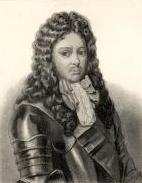Louis d'Aubusson, duc de La Feuillade
Louis d'Aubusson duc de la Feuillade (born March 30, 1673 , † January 28, 1725 at Marly-le-Roi Castle ) was a high-ranking French military man. Most recently he was Marshal of France . He played a notable role during the War of the Spanish Succession .
Life
He was the son of François d'Aubusson, comte de la Feuillade . This too was Marshal of France. The mother was Charlotte de Gouffier. Through this he received the title of Duke of Roannès (called Feuillade).
At the age of fifteen he joined the French army. He took part in the siege of Philippsburg in 1688 . In 1689 he set up a cavalry regiment and fought with it in the Battle of Fleurus in 1690 . After his father's death, he succeeded him as heir. He also took over the office of governor of the Dauphiné from his father . He was one of the richest courtiers. He married Charlotte-Thérèse Phélypeau in 1692. She was the daughter of the Undersecretary of State, Marquis de Chateauneuf.
In 1691 he took part in the siege of Mons . A year later he was involved in the Battle of Steenkerke and the Siege of Namur . In 1693 he took part in the Battle of Neerwind and the Siege of Charleroi . In the following years he served on the Rhine and later again in Flanders. His concept of service was downright sloppy. He is said to have always been the last officer to join the army at the beginning of a campaign and was the first to leave again. His regiment was mostly in bad shape.
He fell out of favor with the king after stealing considerable sums of money and jewels from his uncle, Georges d'Aubusson de La Feuillade , who was Bishop of Metz . Louis XIV , who disapproved of the extravagant lifestyle and the unreliable nature of La Feuillade anyway, sharply criticized him and the duke fell out of favor.
To the displeasure of the king, Feuillade married his second wife Marie-Thérèse Chamillart in 1701. She was the daughter of Finance Minister Michel Chamillart . Through these new relationships at court, he became brigadier des armes du roi in 1702 and maréchal de camp in 1703 . He also commanded the French troops in the Dauphiné after the War of the Spanish Succession began. He owed this command largely to his father-in-law. He was deployed with the troops against Savoy . Under the influence of his father-in-law, he was appointed lieutenant-général . He took over the troops from René de Froulay de Tessé , who was ill. Feuillade was promoted to commander in chief of the army. He marched into Savoy and prevented the recapture of Chambéry . He brought Savoy largely under French control. Thereupon the king received him courteously at Versailles . He blocked Montmélian and besieged Susa .
In 1705 he took Villafrance by storm. More conquests followed. The city of Nice was given to him after a siege. Only the citadel remained in the hands of the enemy. As a result he supported with his troops of Louis II. Joseph de Bourbon, duc de Vendôme . After he was recalled to fight Eugene of Savoy , Feuillade was given command of his troops and now commanded a large army. At first he turned against Chivasso with success .
After all, he had locked Turin in order to complete the conquest of Piedmont . A first attempt at siege failed, also because the troops were insufficient. After the opponents had taken Asti , La Feuillade besieged the city and had to abandon the project due to high losses due to failures.
In 1706 he commanded the siege army again in front of Turin. During the battle of Turin against Viktor Amadeus II of Savoy , Eugene of Savoy and Leopold von Anhalt-Dessau , he was forced to abandon the Duke of Orléans and was carried away by the general escape.
After the defeat, he was released. In 1708 he sold his regiment. From 1716 he was peer of France . In 1719 he gave up his post as governor of the Dauphiné. Through efforts at court, he was appointed Marshal of France in 1724.
literature
- Georg von Alten (Hrsg.): Handbook for Army and Fleet. Encyclopedia of Martial Sciences and Allied Fields. Volume 3, German publishing house Bong & Co, Berlin 1911, p. 720.
- Johann Samuelersch , Johann Gottfried Gruber (Hrsg.): General encyclopedia of the sciences and arts. 1st section, part 33, Leipzig 1840, 186, 419-423.
Web links
- Biography at spanishsuccession.nl (English)
| personal data | |
|---|---|
| SURNAME | Aubusson, Louis d ' |
| BRIEF DESCRIPTION | French military, Marshal of France |
| BIRTH DATE | March 30, 1673 |
| DATE OF DEATH | January 28, 1725 |
| PLACE OF DEATH | Marly-le-Roi Castle |
